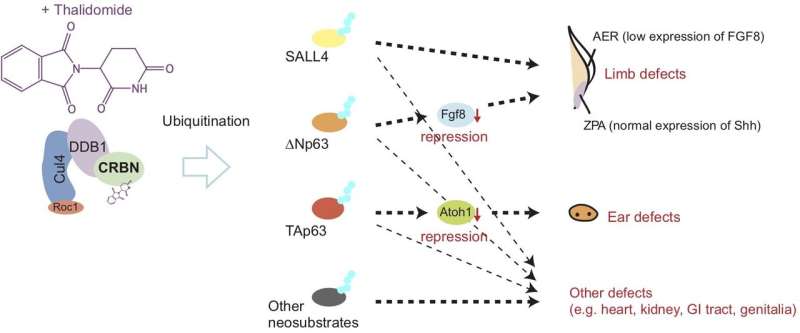Molecular basis of drug's effects on limb and ear development revealed

Researchers in Japan and Italy have deepened understanding of the way in which thalidomide causes developmental abnormalities at the molecular level. An international study co-authored by researchers at Tokyo Institute of technology (Tokyo Tech) and Tokyo Medical University has unveiled a detailed view of how thalidomide, one of the most notorious drugs ever developed, causes abnormalities in limb and ear development. The findings may contribute to the re-emergence of safe, or non-teratogenic, thalidomide-derived drugs as a treatment for cancer and inflammatory diseases.
Originally used in the late 1950s as a treatment for morning sickness, evidence in the early 1960s linked thalidomide to abnormalities including shortened limbs and defective organs, which led to its ban around the world. Remarkably, based on subsequent findings that highlighted thalidomide's anti-inflammatory and other beneficial properties, the drug has become a major example of one that can be repurposed to treat conditions such as leprosy and multiple myeloma, a type of blood cancer.
"The thalidomide tragedy is not an open-and-shut case in medical history, but is ongoing, as new thalidomide babies have been born after its re-approval in around 2000," explains biochemist Yuki Yamaguchi of Tokyo Tech. "But we now know that thalidomide and its derivative drugs are highly effective and are associated with few side-effects, except for the teratogenic effects on the fetus, unlike many other conventional anti-cancer agents. Therefore, teratogenicity remains a big hurdle for wider application of these promising drugs."
To investigate the mechanisms behind thalidomide activity in more detail, Yamaguchi collaborated with Hiroshi Handa of Tokyo Medical University, Luisa Guerrini of Universita degli Studi di Milano, Italy, and others to conduct developmental studies using zebrafish as a model organism. This collaboration set out to explore Guerrini's hunch that the p63 family of proteins might be critically involved. In 2010, a team led by Handa and Yamaguchi achieved a breakthrough by identifying cereblon as a key protein through which thalidomide initiates its adverse or teratogenic effects.
Now, the latest study published in Nature Chemical Biology shows that after binding to cereblon, thalidomide causes damage to fins (corresponding to limbs) and to otic vesicles (corresponding to ears) by inducing the breakdown of two types of p63 protein. Specifically, the study suggests that the breakdown of ΔNp63α results in limb defects, while that of TAp63α leads to ear defects, as shown in Figure 1.
Understanding how cereblon works to mediate the effects of thalidomide could transform the way drugs are developed—moving away from serendipitous discovery and towards rational molecular design. "The change would be like a shift from looking for a needle in a haystack to carving a needle out of bone," Yamaguchi notes.
"It's likely that we will see the development of new thalidomide-based drugs without teratogenic effects in the near future," he says.
More information: Tomoko Asatsuma-Okumura et al, p63 is a cereblon substrate involved in thalidomide teratogenicity, Nature Chemical Biology (2019). DOI: 10.1038/s41589-019-0366-7
Journal information: Nature Chemical Biology
Provided by Tokyo Institute of Technology



















